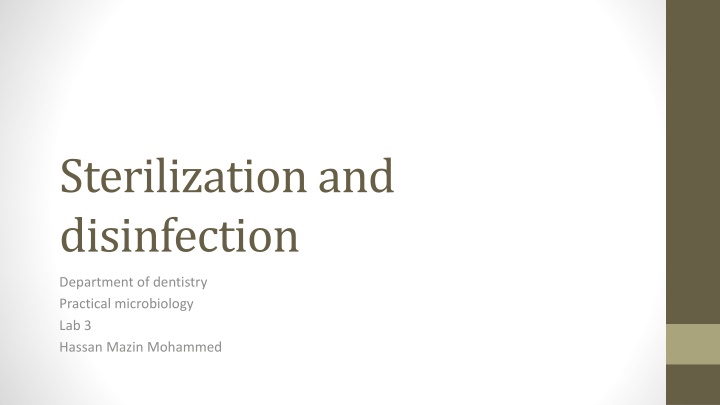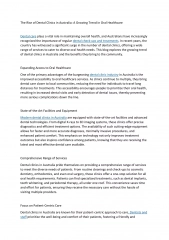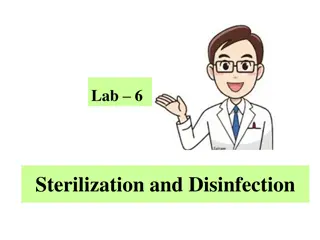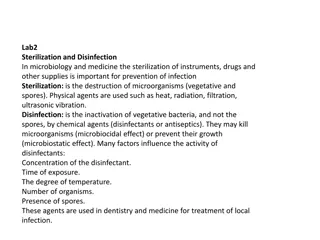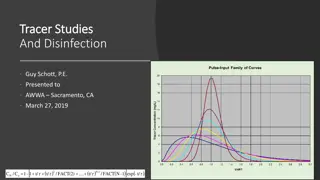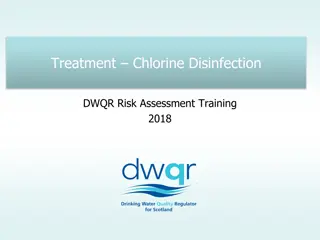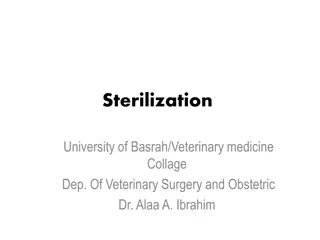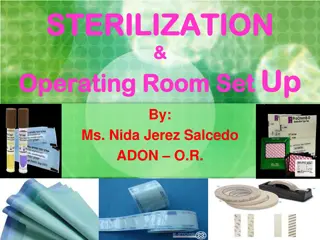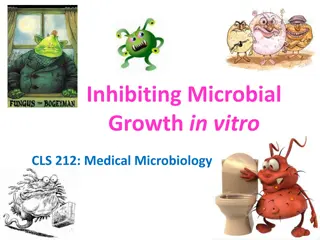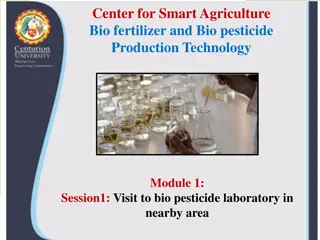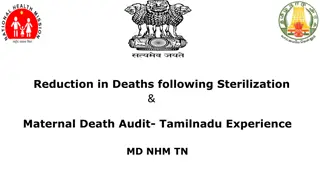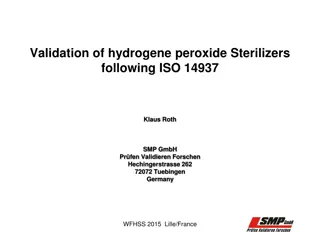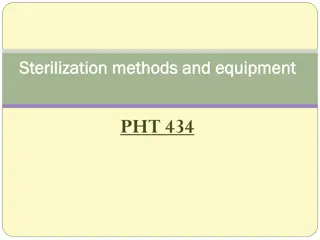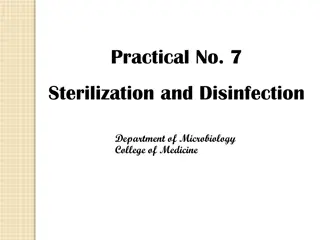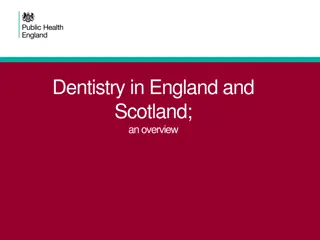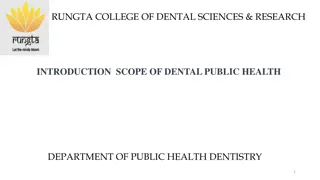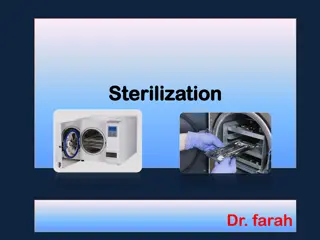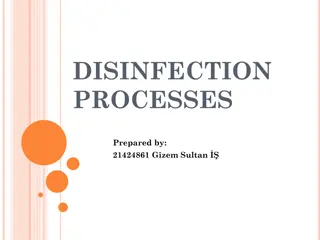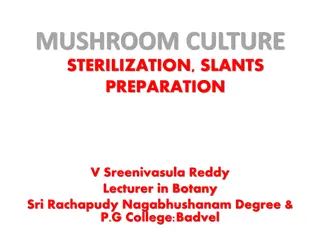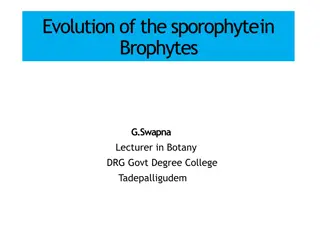Sterilization and Disinfection in Dentistry Practical Microbiology
Sterilization and disinfection are crucial processes in dentistry to ensure the removal or prevention of microbial growth. Physical and chemical methods, such as heat, filtration, and radiation, are used for sterilization. Dry heat, moist heat, flaming, and hot air ovens are common techniques employed. Understanding these methods is vital for maintaining a sterile environment in dental settings.
Uploaded on Feb 16, 2025 | 2 Views
Download Presentation

Please find below an Image/Link to download the presentation.
The content on the website is provided AS IS for your information and personal use only. It may not be sold, licensed, or shared on other websites without obtaining consent from the author.If you encounter any issues during the download, it is possible that the publisher has removed the file from their server.
You are allowed to download the files provided on this website for personal or commercial use, subject to the condition that they are used lawfully. All files are the property of their respective owners.
The content on the website is provided AS IS for your information and personal use only. It may not be sold, licensed, or shared on other websites without obtaining consent from the author.
E N D
Presentation Transcript
Sterilization and disinfection Department of dentistry Practical microbiology Lab 3 Hassan Mazin Mohammed
Sterilization: its a physical or chemical process that completely destroy or removes all microbial life, including spores. Disinfection: it s a physical or chemical process that kill or prevent the growth of pathogenic microorganism but not necessarily the spores.
Sterilization methods: there are many methods for sterilization, in general its divided into two methods: A. physical methods B. chemical methods
A. Physical methods: the physical methods are further divided into three ways 1. Heat 2. Filtration 3. Radiation
1. Heat: This method is divided into two types, dry heat and moist heat. Dry heat: a. Red heat: in this method, the tools (especially the metallic ones) are exposed to the flame of benzene burner until reaching the red color. These tools include loops, inoculation needles, forceps. The tools which are sterilized by using the red heat method are made of steel that resist oxidation and high temperature.
b. Flaming: in this method, the tools are exposed to the flame of benzene burner without allowing them to reach the redness point. The tools include the mouth of the test tubes and flasks, slides and cover slips (cover slide). * For more accurate operation, alcohol can be used by spreading it on the tools before exposure to the flame, like knives used in surgery, medical syringes, etc.
c. Hot air oven: in this method, the tools are sterilized at (160-180) C for (1-2) hrs. it is a perfect method for glass wares sterilization. The glass wares include: tubes, flasks, petri dishes and pipettes. * This method is suitable for sterilization of metallic tools that are not affected by high temp. e.g. knives and forceps. * Water on glass wares must be dried before using this technique to avoid breaking.
Moist heat a. Pasteurization: in this method, sterilization is done by using temp. less than (100) C to destroy pathogenic bacteria by heating (62) C for (30) minutes (LTLT) or (72) C for (15) seconds (HTLT). The materials used by this methods are serum, body liquids (like albumin) and milk.
b. Boiling In this method, sterilization is done by using (100) C for (10) minutes. It is enough to kill all pathogenic m.o. in vegetative phase (not their spores). This method used when there is no alternative method of sterilization. It is used for sterilization of materials and instruments which are metallic or glass.
c. Tyndallization or steaming In this method, sterilization is done by exposing the materials to the vapor of boiling water for a couple of minutes and for 3 days in sequence . The materials which are sterilized by this method are: sugar solutions, enzymes, vitamins and antibiotics.
This method is used for sterilization of the material which may be destroyed by using the high temperature. The sterilization in this method is done for 3 days in sequence because 1stday ----- the vegetative cells are killed 2ndday ---- the spores convert into vegetative cells 3rdday ----- the converted vegetative cells are killed, in addition the sterilization process is completed effectively
d. Autoclave In this method, sterilization is done by using temperature higher than (100 C ) (steam + pressure). The materials and instruments (glass or plastic) which are sterilized by this method are: culture media, solutions and liquids, cottons, other materials which are usually destroyed by using dry sterilization (oven).
The reason of using autoclave (moist heat) for the sterilization of cultural media and other liquids is the existence of the steam which prevent the vaporization of the media and other watery solutions by heating, but if these media and solutions are sterilized by an oven (dry heat), they will be decreased in volume because of the oven environment that leads to the vaporization of these solutions. The sterilization using an autoclave kill all kinds of pathogenic microorganism and their spores (which can not be killed by other sterilization methods)
2. Filtration This method involves filtering the solutions or any other liquids through special sterile filter. These filters allow the liquid to penetrate while the m.o. are trapped on the surface of the filter. The materials which are sterilized are: serum, enzymes, vitamins, antibiotics and sugar solutions.
The most important filters are cellulose membrane filters which are made of cellulose nitrate or cellulose acetate like Millipore filters. This type of filters is common because: 1- the membrane filter disc can be directly removed and placed on surface of an appropriate (suitable) solid medium in order to make the microorganism grow on that medium, so the growth characteristics can be studied. 2- high speed of filtration.
3. Radiation The ability of the sunlight to kill the m.o. is due to the ultra violet (uv) ray existence in it. The rays can be divided into: 1- Non-ionizing ray like uv light which is effective in the wavelength about (240-280) nm. Uses: sterilization of hospitals, laboratories, meat package factories. Note: the sterilization by using uv is more effective on a clean surface because its inability to penetrate more than some millimeters in liquids and solid surface, so it is used only to sterilize clean surface.
2- Gamma ray Uses: sterilization of food products, penicillin, plastic items (which can be consumed). B. Chemical methods Those methods are used for the sterilization of rooms and floor. The efficiency of those methods depends on: 1. Chemical agents concentration. 2. Time period required for sterilization. 3. quantity and quality of microorganism.
Disinfection or antiseptic It is a chemical agent or materials which have the ability to kill or prevent growth or slow the metabolism of m.o. vegetative cells but it has no effect on their spores.
Disinfectant: 1.Volatile disinfectant chloroform. uses: serum which added to the cultural media, it can be used in the form of liquid or concentrated vapor state by exposing the liquid or contaminated surface to it for about (1) min. 2. Phenols --- Lysol, cresol, hycoline, phenol. Uses: surgical tools, bacterial culture, serum, vaccines.
3. Metallic salts or heavy organic compounds of metals --- mercuric chloride 4. Gases --- formaldehyde. Advantages: *not expensive *water soluble *effective for killing all kinds of m.o. and their spores *have no damaging effect to the surfaces to be disinfected
Disadvantage: this gas causes irritation of the respiratory tract when it is inhaled. Uses: rooms, laboratory environment, laboratory cultures (formalin). Note: the gas (formaldehyde) is used for the disinfection of the materials that cannot be exposed to the liquid solutions which may damage those materials.
5. Halogens --- chlorine uses: water disinfection --- iodine uses: wounds disinfection 6. Alcohol --- ethanol with the concentration of (70-75)%, this concentration causes melting (lysis) and damaging of lipid membranes and denaturation of the microbial cell proteins. Note: alcohol with 70% concentration is more effective than absolute alcohol, and this is due to the m.o. cell wall proteins which are more soluble and easily damaged when used diluted alcohol.
sterilization physical chemical radiation filtration heat Dry heat Moist heat boiling pasteurization tyndallization autoclave Red heat flaming Hot air oven
